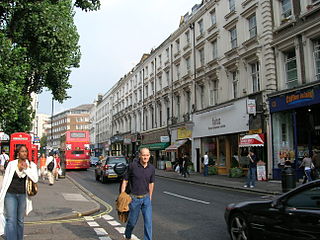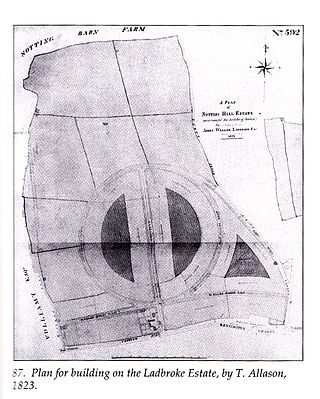
Notting Hill is a district of West London, England, in the Royal Borough of Kensington and Chelsea. Notting Hill is known for being a cosmopolitan and multicultural neighbourhood, hosting the annual Notting Hill Carnival and the Portobello Road Market. From around 1870, Notting Hill had an association with artists.

Notting Hill Gate is a London Underground station near Notting Hill, London, located on the street called Notting Hill Gate. It is served by three lines: Central, Circle and District. On the Central line, the station is between Holland Park and Queensway stations. On the Circle and District lines, it is between High Street Kensington and Bayswater stations. It is on the boundary of Travelcard Zone 1 and Zone 2.

Portobello Road is a street in the Notting Hill district of the Royal Borough of Kensington and Chelsea in West London. It runs almost the length of Notting Hill from South to North, roughly parallel with Ladbroke Grove. On Saturdays it is home to Portobello Road Market, one of London's notable street markets, known for its second-hand clothes, pastries and antiques. Every August since 1996, the Portobello Film Festival has been held in locations around Portobello Road and, in 2015, Portobello Radio was founded as the area's community radio station.

Westbourne Grove is a retail road running across Notting Hill, an area of west London. Its western end is in the Royal Borough of Kensington and Chelsea and its eastern end is in the City of Westminster; it runs from Kensington Park Road in the west to Queensway in the east, crossing over Portobello Road. It contains a mixture of independent and chain retailers, and has been termed both "fashionable" and "up-and-coming".

Notting Hill Gate is one of the main thoroughfares in the Royal Borough of Kensington and Chelsea. Historically the street was a location for toll gates, from which it derives its modern name.

Perec "Peter" Rachman was a Polish-born landlord who operated in Notting Hill, London, England, in the 1950s and early 1960s. He became notorious for his exploitation of his tenants, with the word "Rachmanism" entering the Oxford English Dictionary as a synonym for the exploitation and intimidation of tenants.

Lancaster Gate is a mid-19th century development in the Bayswater district of central London, immediately to the north of Kensington Gardens.

Regent's Park and Kensington North was a constituency in Central and West London represented in the House of Commons of the UK Parliament. It elected one Member of Parliament (MP) by the first past the post system of election from 1997 to 2010.

Kensington is a former constituency in Greater London which first existed between 1974 and 1997 and was recreated in 2010. It was replaced by the Kensington and Bayswater constituency, first contested at the 2024 general election.

The Tabernacle is a Grade II-listed building in Powis Square, Notting Hill, west London, England, built in 1887 as a church. The building boasts a curved Romanesque façade of red brick and terracotta, and two towers with broach spires on either side. Today the Tabernacle serves as a cultural arts and entertainment venue, including a theatre, meeting rooms, music studio, art gallery, bar and kitchen, conservatory and a garden courtyard.

All Saints Notting Hill is a Church of England parish church in Talbot Road, Notting Hill, London that is affiliated to the Anglo-Catholic Forward in Faith movement. The church is built in a Victorian Gothic Revival style with striking polychromatic decoration. For heritage purposes the church is a Grade II* listed building.

The Royal Crescent is a Grade II* listed street in Holland Park, west London, England, consisting of two curved facing terraces in a crescent shape. The crescent is located on the north side of Holland Park Avenue, west of Addison Avenue, and to the east of the Holland Park Roundabout. St Ann's Villas leads north off the Crescent.

Colville Gardens is a Victorian cul-de-sac street in the Royal Borough of Kensington and Chelsea, located north of Colville Terrace and east of the Portobello Market in Notting Hill, London, England. It is bordered on the north side by All Saints' Church.

St Peter's Notting Hill is a Victorian Anglican church in Kensington Park Road, Notting Hill, London. Designed in the classical style by architect Thomas Allom, work was begun in 1855 and completed in 1857.

The Ladbroke Estate was a substantial estate of land owned by the Ladbroke family in Notting Hill, London, England, in the early 19th century that was gradually developed and turned into housing during the middle years of the century, as London expanded. Characterized by terraces of stuccoed brick houses backing onto large private garden squares, much of the original building remains intact today, and now forms the heart of one of London's most expensive and fashionable neighbourhoods.

Arundel Gardens is a street and a communal garden square in Notting Hill, London, one of seven streets between Ladbroke Grove and Kensington Park Road of which five share in a communal garden between them. It was built in the 1860s, towards the later stages of the development of the Ladbroke Estate, until that decade part of the rural hinterland of London. Notable past residents of the street include psychologist Charles Samuel Myers, who coined the term shell shock, and the Nobel Prize-winning chemist Sir William Ramsay, discoverer of the noble gases.

The Electric Cinema is a cinema in Notting Hill, London.

Powis Square is a garden square and locality in Notting Hill, in the Royal Borough of Kensington and Chelsea in London, England. The closest London Underground station to the square is Westbourne Park tube station.

George Frederick John Tippett was an English builder and entrepreneur who developed much of the former St Quintin Estate in Notting Hill, London. He is responsible for the construction of many buildings in the area which remain today, including Pinehurst Court, a portered Victorian mansion block at 1-9 Colville Gardens in Notting Hill.

Lancaster Road (West) Estate is a housing estate in North Kensington, west London.




















